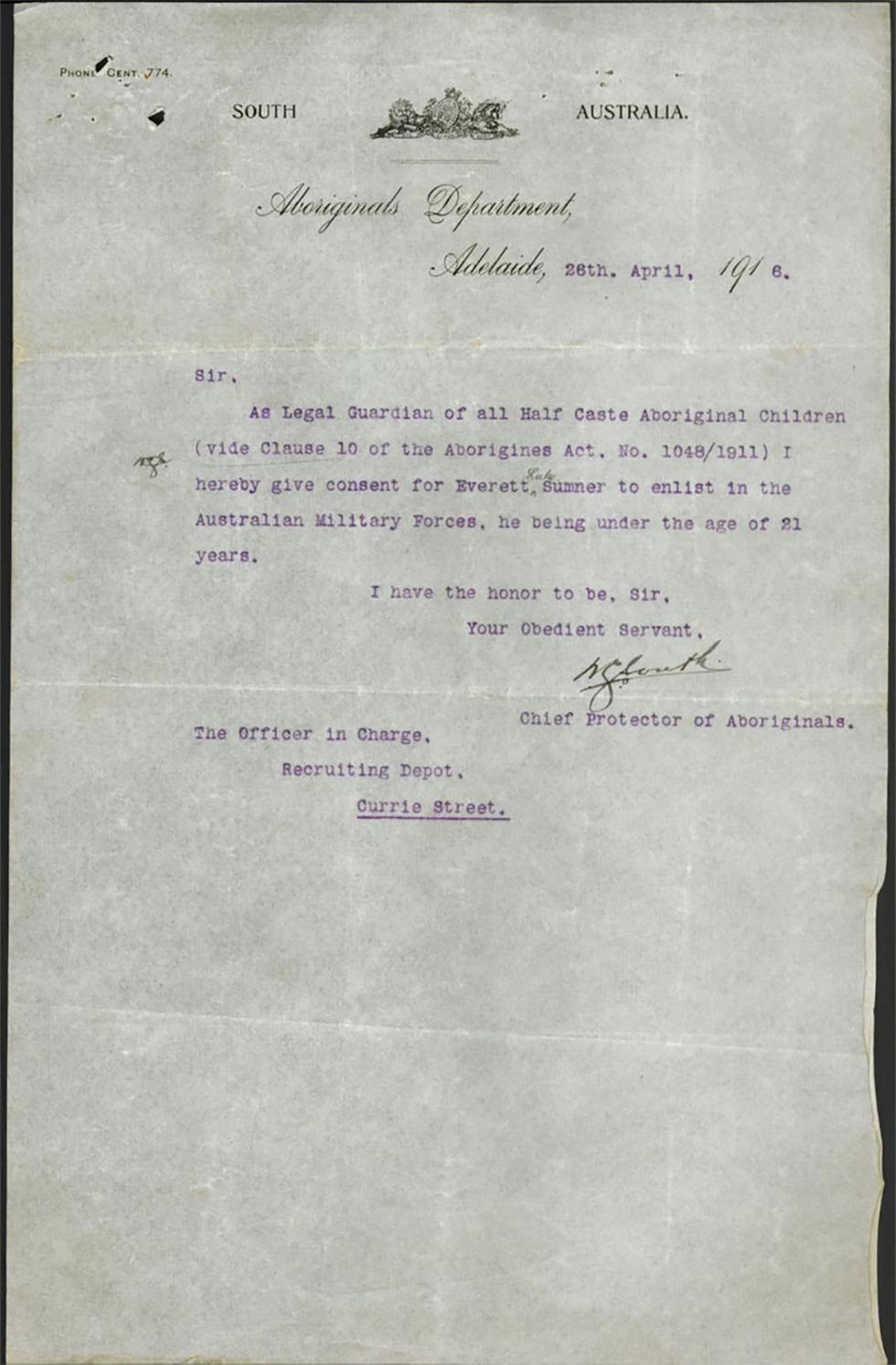


Transcript
[Letterhead in black ink displaying a coat of arms between the words 'SOUTH' and 'AUSTRALIA'. Letterhead continues 'Aboriginals Department', 'Adelaide', and then leaves a space for the typewritten date '26th. April, 1916.']
Sir,
As Legal Guardian of all Half Caste Aboriginal Children (vide Clause 10 of the Aborigines Act. No. 1048/1911) I hereby give consent for Everett [inserted handwritten word 'Luke'] Sumner to enlist in the Australian Military Forces, he being under the age of 21 years.
I have the honor to be, Sir,
Your Obedient Servant,
[Handwritten signature:] WG South
Chief Protector of Aboriginals.
[Addressed to:] The Officer in Charge,
Recruiting Depot,
Currie Street. [underlined]
About this record
This letter provides consent from the Chief Protector of Aboriginals for Everett Luke Sumner to serve in the First World War. Sent by the Aboriginals Department in Adelaide on 26 April 1916, it forms part of Sumner's service record.
Educational value
- Everett Luke Sumner was born on Point McLeay mission, south-east of Adelaide. A person under the age of 21 had to gain permission from their guardian to enlist and, as Sumner was Aboriginal, the Chief Protector was considered his legal guardian. Sumner enlisted in April 1916 at age 19.
- Like other enlistees, Aboriginal and Torres Strait Islander people viewed serving as an opportunity to broaden their horizons, for travel and adventure, or as a means to provide a better life for their family. For Sumner and other Aboriginal and Torres Strait Islander people living on missions, the war often brought greater independence than previously experienced. The strong connection of Aboriginal and Torres Strait Islander peoples to Country may have also motivated people to enlist.
- Sumner served in England and France and was absent without leave several times. On one occasion, after being absent from 4.45 am to 2.30 pm, he was fined eight days' pay (about two pounds) and received a 'Field punishment No. 2'. This may have consisted of heavy labour and being restrained in handcuffs.
- Sumner was discharged and returned to the Point McLeay Mission Station in June 1919. He took up work on shearing stations and railways around South Australia.
- In 1947 Sumner was granted a ‘Certificate of Exemption’ due to his army service, which meant that he was no longer under the same constraints as other Aboriginal people. Having the certificate allowed Sumner to open a bank account, own land, receive some government benefits and purchase alcohol. However, it also meant that he was unable to live with or visit his family on missions.
- In 1966, Sumner died of a cerebral thrombosis—a blood clot in the brain—at a repatriation hospital in Adelaide. His personal effects at the time of his death consisted of a pair of grey trousers, a chequered shirt, a grey hat, a singlet, two combs, one tin of baby powder, one unopened letter, two cigarettes, one box of used matches, one coat hanger and $2.23.
Related themes
Need help with your research?
Learn how to interpret primary sources, use our collection and more.


